Abstract
A gas chromatographic procedure was developed to determine the relative amounts of D- and L-arabinitol in urine. Samples were filtered, diluted, purified through extractions, evaporated, and treated with trifluoroacetic anhydride; the arabinitol derivatives thus obtained were separated on a chiral stationary phase and registered by using an electron-capture detector. Urine samples from a patient with disseminated candidiasis had higher D-arabinitol/L-arabinitol ratios (referred to as D/L-arabinitol ratios)--up to 19.0--than samples from 96 study individuals with no signs of deep Candida infections (range, 1.1 to 4.5). D/L-Arabinitol ratios in urine samples from hospitalized patients without Candida infections were slightly higher than those in samples from healthy individuals; ratios in urine from children were slightly higher than those in adult urine samples. The D/L-arabinitol ratios in several urine samples culture positive for Candida albicans, but from patients without symptoms of disseminated candidiasis, did not differ from those in the urine of healthy individuals. The described gas chromatographic method is straightforward and can be implemented clinically to determine urine D/L-arabinitol ratios as a means of diagnosing disseminated candidiasis.
Full text
PDF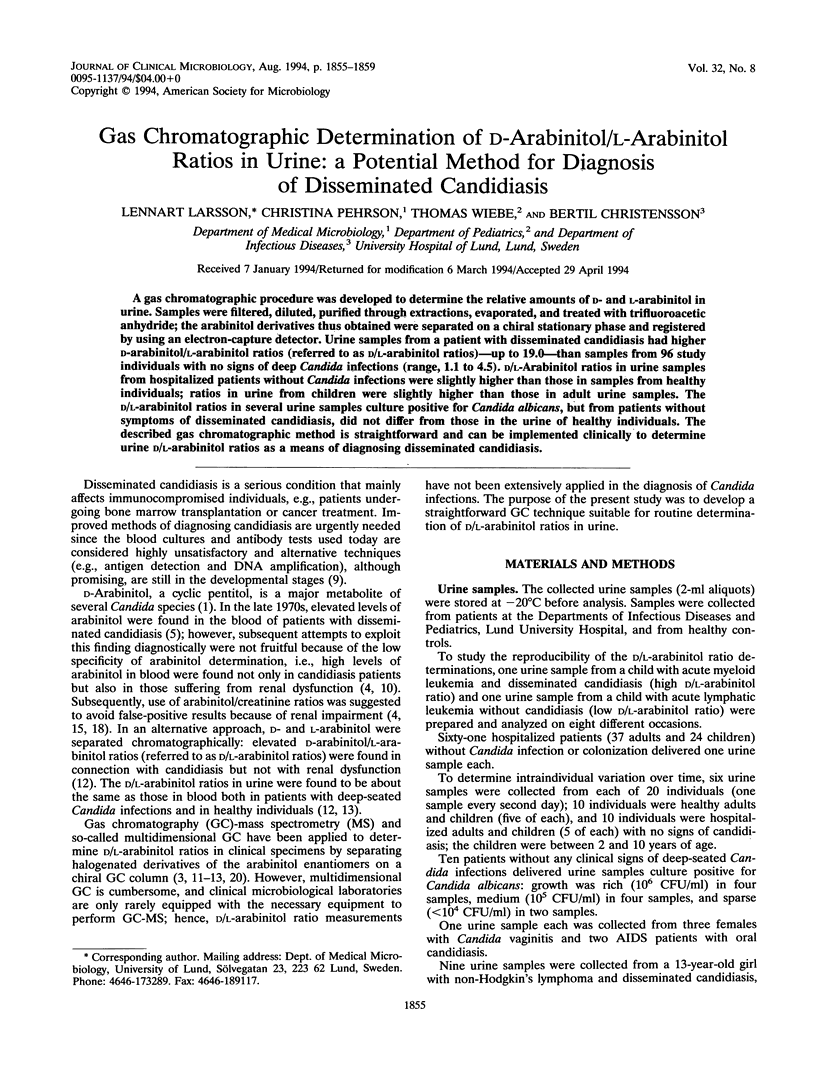
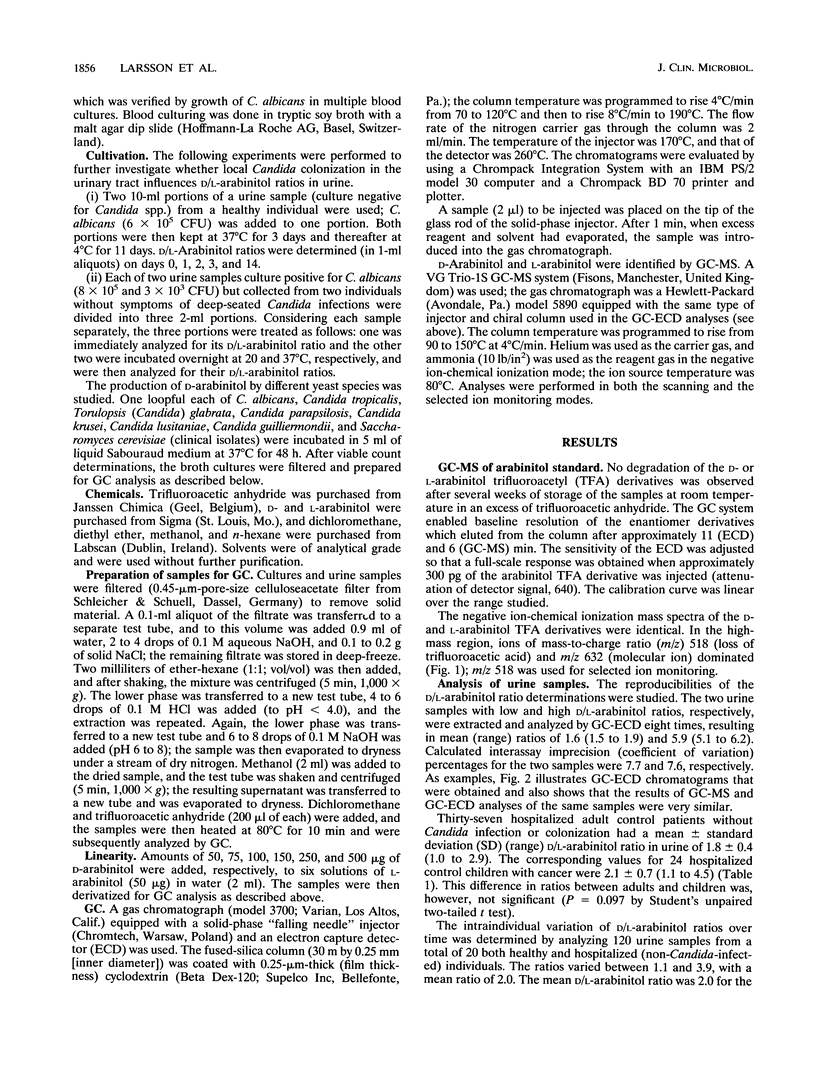
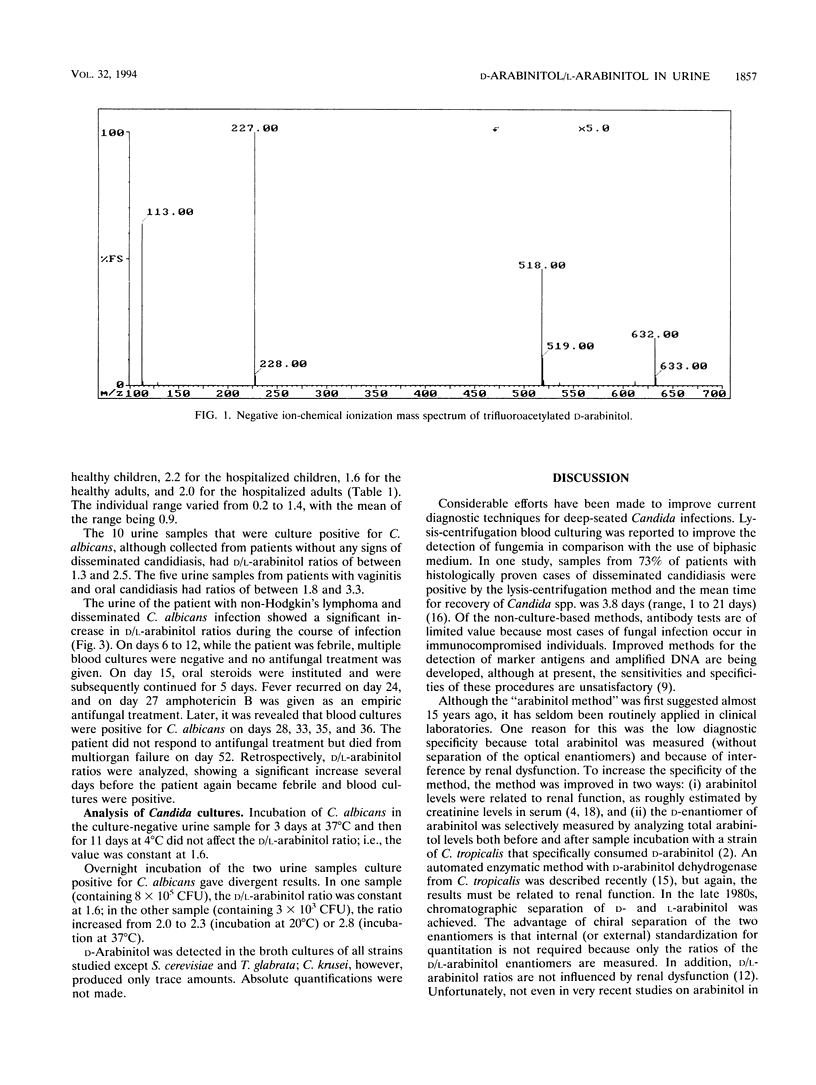
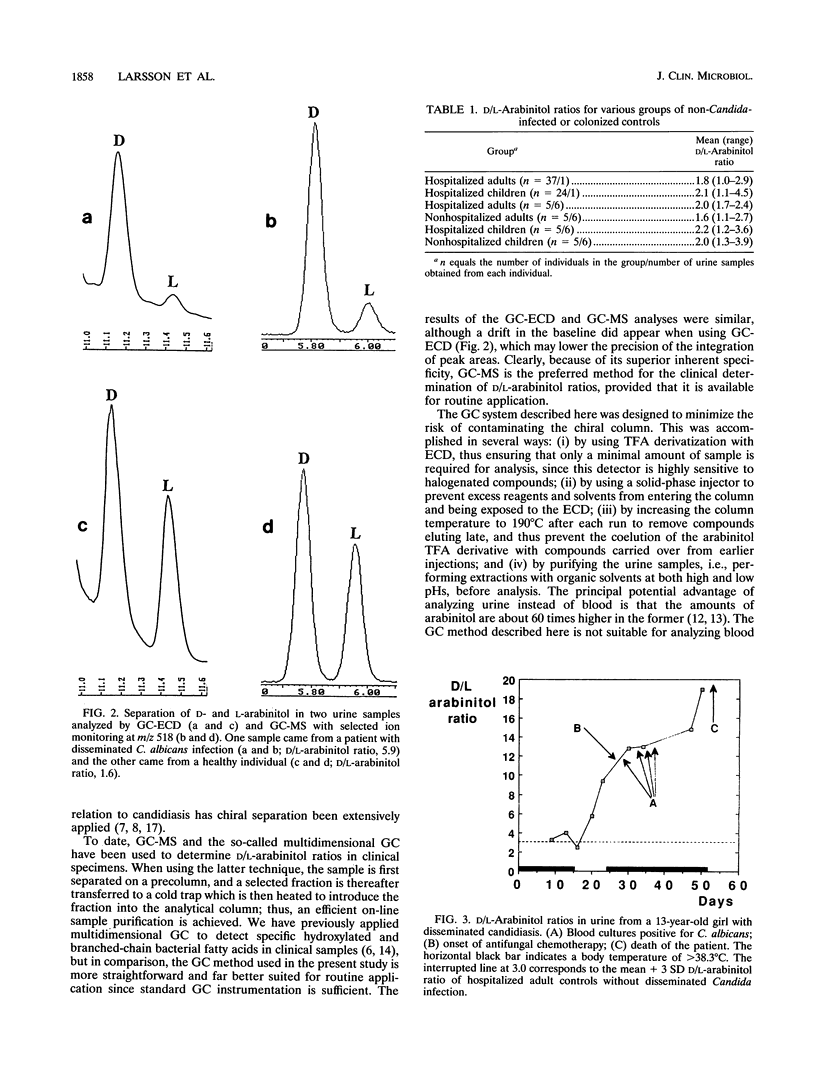
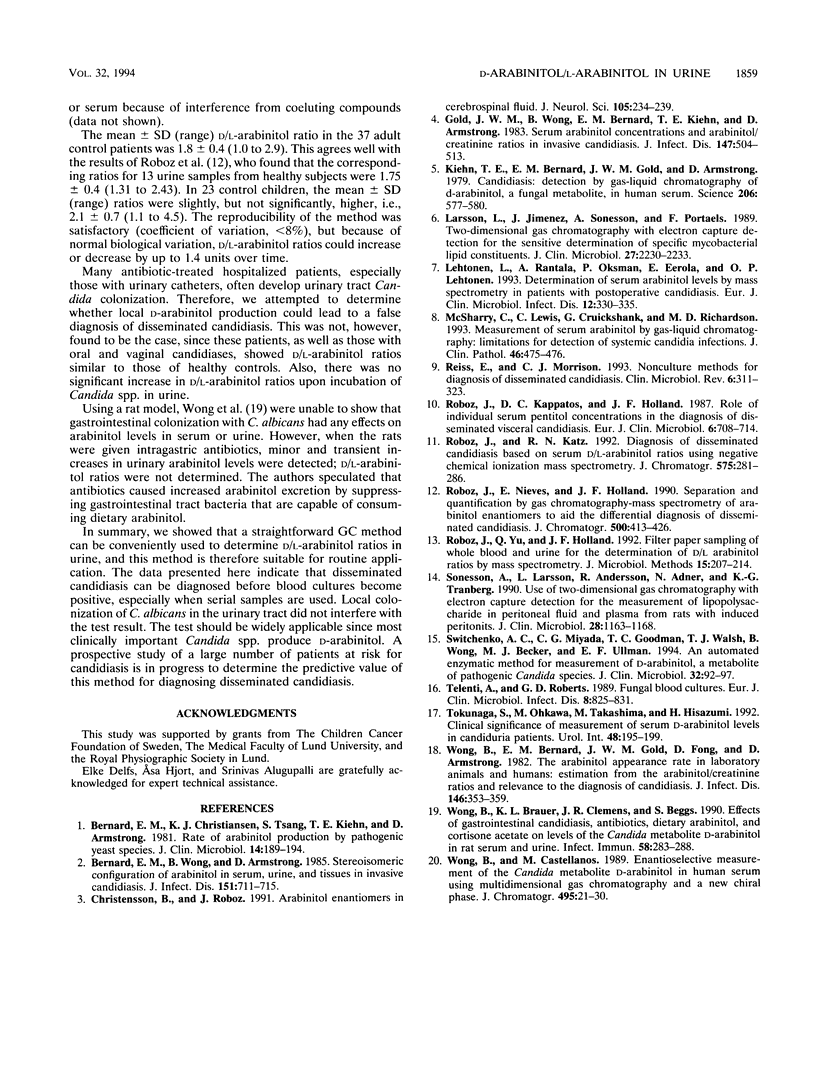
Selected References
These references are in PubMed. This may not be the complete list of references from this article.
- Bernard E. M., Christiansen K. J., Tsang S. F., Kiehn T. E., Armstrong D. Rate of arabinitol production by pathogenic yeast species. J Clin Microbiol. 1981 Aug;14(2):189–194. doi: 10.1128/jcm.14.2.189-194.1981. [DOI] [PMC free article] [PubMed] [Google Scholar]
- Bernard E. M., Wong B., Armstrong D. Stereoisomeric configuration of arabinitol in serum, urine, and tissues in invasive candidiasis. J Infect Dis. 1985 Apr;151(4):711–715. doi: 10.1093/infdis/151.4.711. [DOI] [PubMed] [Google Scholar]
- Christensson B., Roboz J. Arabinitol enantiomers in cerebrospinal fluid. J Neurol Sci. 1991 Oct;105(2):234–239. doi: 10.1016/0022-510x(91)90150-6. [DOI] [PubMed] [Google Scholar]
- Gold J. W., Wong B., Bernard E. M., Kiehn T. E., Armstrong D. Serum arabinitol concentrations and arabinitol/creatinine ratios in invasive candidiasis. J Infect Dis. 1983 Mar;147(3):504–513. doi: 10.1093/infdis/147.3.504. [DOI] [PubMed] [Google Scholar]
- Kiehn T. E., Bernard E. M., Gold J. W., Armstrong D. Candidiasis: detection by gas-liquid chromatography of D-arabinitol, a fungal metabolite, in human serum. Science. 1979 Nov 2;206(4418):577–580. doi: 10.1126/science.493963. [DOI] [PubMed] [Google Scholar]
- Larsson L., Jimenez J., Sonesson A., Portaels F. Two-dimensional gas chromatography with electron capture detection for the sensitive determination of specific mycobacterial lipid constituents. J Clin Microbiol. 1989 Oct;27(10):2230–2233. doi: 10.1128/jcm.27.10.2230-2233.1989. [DOI] [PMC free article] [PubMed] [Google Scholar]
- Lehtonen L., Rantala A., Oksman P., Eerola E., Lehtonen O. P. Determination of serum arabinitol levels by mass spectrometry in patients with postoperative candidiasis. Eur J Clin Microbiol Infect Dis. 1993 May;12(5):330–335. doi: 10.1007/BF01964428. [DOI] [PubMed] [Google Scholar]
- McSharry C., Lewis C., Cruickshank G., Richardson M. D. Measurement of serum arabinitol by gas-liquid chromatography: limitations for detection of systemic candida infections. J Clin Pathol. 1993 May;46(5):475–476. doi: 10.1136/jcp.46.5.475. [DOI] [PMC free article] [PubMed] [Google Scholar]
- Reiss E., Morrison C. J. Nonculture methods for diagnosis of disseminated candidiasis. Clin Microbiol Rev. 1993 Oct;6(4):311–323. doi: 10.1128/cmr.6.4.311. [DOI] [PMC free article] [PubMed] [Google Scholar]
- Roboz J., Kappatos D. C., Holland J. F. Role of individual serum pentitol concentrations in the diagnosis of disseminated visceral candidiasis. Eur J Clin Microbiol. 1987 Dec;6(6):708–714. doi: 10.1007/BF02013083. [DOI] [PubMed] [Google Scholar]
- Roboz J., Katz R. N. Diagnosis of disseminated candidiasis based on serum D/L-arabinitol ratios using negative chemical ionization mass spectrometry. J Chromatogr. 1992 Mar 27;575(2):281–286. doi: 10.1016/0378-4347(92)80157-l. [DOI] [PubMed] [Google Scholar]
- Roboz J., Nieves E., Holland J. F. Separation and quantification by gas chromatography-mass spectrometry of arabinitol enantiomers to aid the differential diagnosis of disseminated candidiasis. J Chromatogr. 1990 Feb 2;500:413–426. doi: 10.1016/s0021-9673(00)96082-5. [DOI] [PubMed] [Google Scholar]
- Sonesson A., Larsson L., Andersson R., Adner N., Tranberg K. G. Use of two-dimensional gas chromatography with electron-capture detection for the measurement of lipopolysaccharides in peritoneal fluid and plasma from rats with induced peritonitis. J Clin Microbiol. 1990 Jun;28(6):1163–1168. doi: 10.1128/jcm.28.6.1163-1168.1990. [DOI] [PMC free article] [PubMed] [Google Scholar]
- Switchenko A. C., Miyada C. G., Goodman T. C., Walsh T. J., Wong B., Becker M. J., Ullman E. F. An automated enzymatic method for measurement of D-arabinitol, a metabolite of pathogenic Candida species. J Clin Microbiol. 1994 Jan;32(1):92–97. doi: 10.1128/jcm.32.1.92-97.1994. [DOI] [PMC free article] [PubMed] [Google Scholar]
- Telenti A., Roberts G. D. Fungal blood cultures. Eur J Clin Microbiol Infect Dis. 1989 Sep;8(9):825–831. doi: 10.1007/BF02185855. [DOI] [PubMed] [Google Scholar]
- Tokunaga S., Ohkawa M., Takashima M., Hisazumi H. Clinical significance of measurement of serum D-arabinitol levels in candiduria patients. Urol Int. 1992;48(2):195–199. doi: 10.1159/000282330. [DOI] [PubMed] [Google Scholar]
- Wong B., Bernard E. M., Gold J. W., Fong D., Armstrong D. The arabinitol appearance rate in laboratory animals and humans: estimation from the arabinitol/creatine ratio and relevance to the diagnosis of candidiasis. J Infect Dis. 1982 Sep;146(3):353–359. doi: 10.1093/infdis/146.3.353. [DOI] [PubMed] [Google Scholar]
- Wong B., Brauer K. L., Clemens J. R., Beggs S. Effects of gastrointestinal candidiasis, antibiotics, dietary arabinitol, and cortisone acetate on levels of the Candida metabolite D-arabinitol in rat serum and urine. Infect Immun. 1990 Feb;58(2):283–288. doi: 10.1128/iai.58.2.283-288.1990. [DOI] [PMC free article] [PubMed] [Google Scholar]
- Wong B., Castellanos M. Enantioselective measurement of the Candida metabolite D-arabinitol in human serum using multi-dimensional gas chromatography and a new chiral phase. J Chromatogr. 1989 Oct 27;495:21–30. doi: 10.1016/s0378-4347(00)82606-7. [DOI] [PubMed] [Google Scholar]


